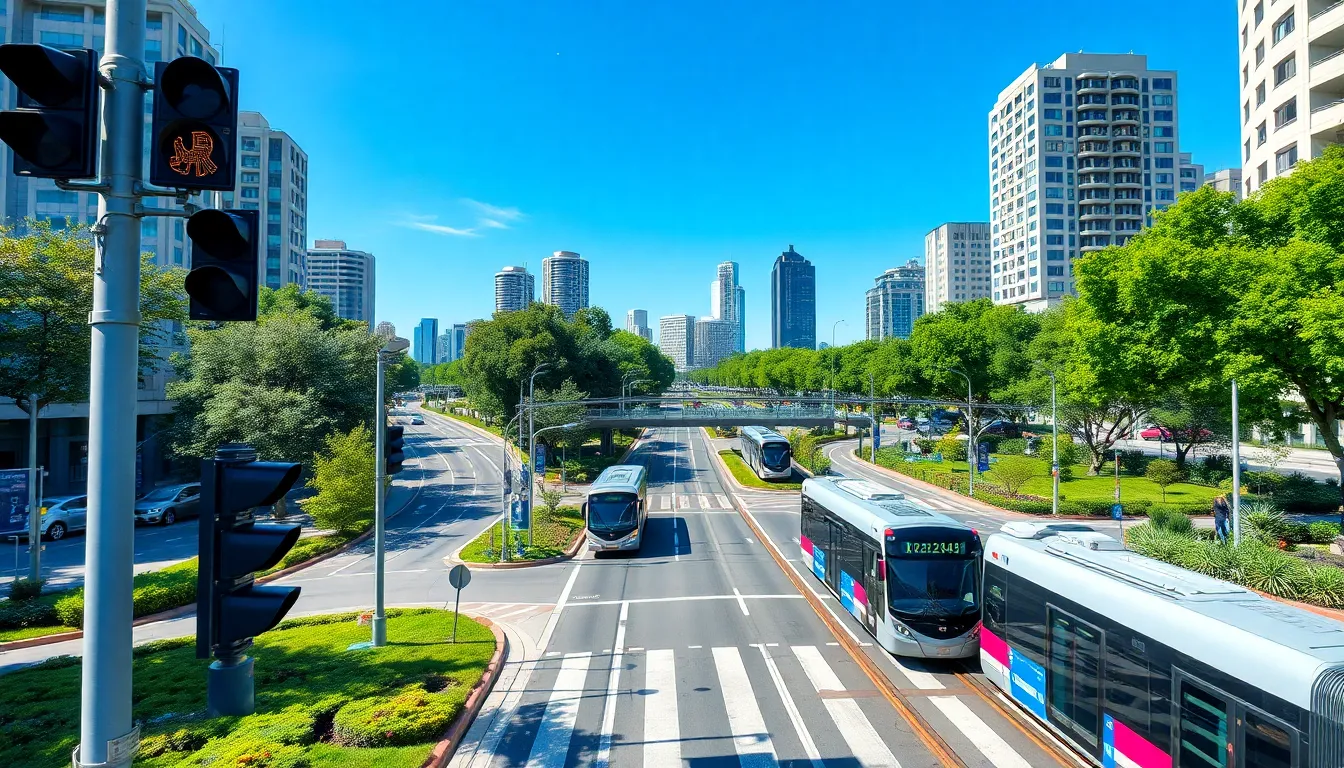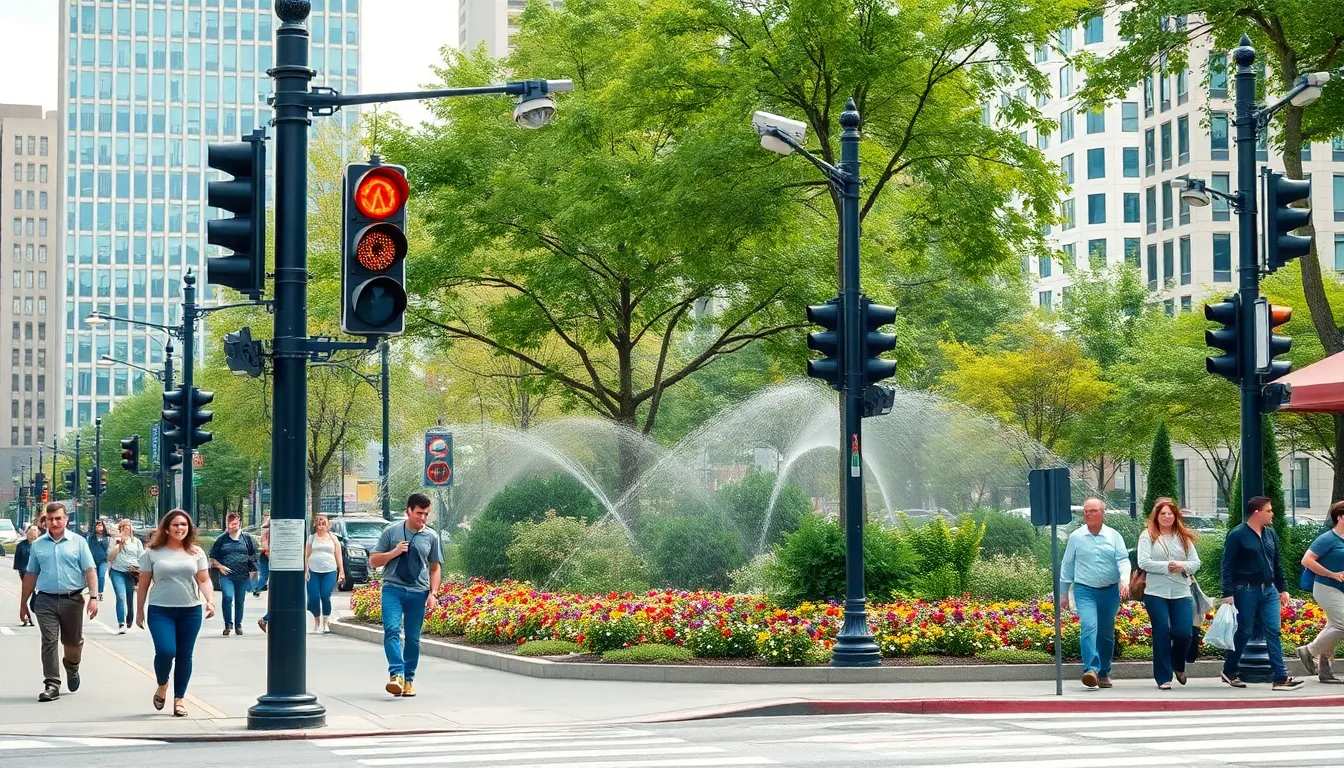In a world where traffic lights might just be smarter than your average human, urban AI deployment is shaking things up. Cities are embracing this tech revolution, turning mundane urban life into a high-tech playground. Imagine a city where your morning commute is smoother than your coffee and your local park knows when to water the flowers—all thanks to AI.
Table of Contents
ToggleOverview of Urban AI Deployment
Urban AI deployment significantly influences city infrastructure and daily activities. This technology optimizes traffic management systems, ensuring vehicles experience reduced congestion and improved travel times. Data from studies shows smart traffic lights can cut delays by 30% during peak hours.
Air quality monitoring systems benefit from AI as well. Using real-time data, these systems provide actionable insights to reduce pollution levels. Cities with deployed air quality management solutions notice a decrease in asthma cases linked to air toxicity.
Smart resource management exemplifies urban AI’s effectiveness. Parks equipped with AI systems monitor soil moisture and temperature, automatically adjusting irrigation to ensure adequate plant health. Cities employing such technology save 20% on water usage and sustain greener environments.
Public safety measures improve significantly with AI integration. Surveillance systems analyze video feeds, detecting anomalies and enhancing response times during emergencies. Police departments using AI tools report faster identification of crime patterns.
Urban planning also advances through AI’s analytical capabilities. Predictive models based on demographic data assist in forecasting growth and infrastructure needs. Cities pursuing AI for urban development realize a 15% increase in overall project efficiency.
Overall, urban AI deployment represents a groundbreaking shift in how cities function. With continuous advancements in technology, cities can expect ongoing enhancements to urban living standards.
Key Technologies in Urban AI

Urban AI relies on innovative technologies that enhance city life. Its potential transforms infrastructure and daily activities through advanced capabilities.
Machine Learning Applications
Machine learning serves as a cornerstone for urban AI. Predictive algorithms analyze traffic patterns, enabling significant reductions in congestion and travel time. Algorithms improve public transportation efficiency by dynamically adjusting schedules based on real-time demand. Fraud detection systems decrease instances of service abuse, optimizing resource allocation. Insights from historical data guide city planners in making informed decisions about infrastructure investments and development. These applications collectively raise the standard of urban living through data-driven solutions.
IoT Integration
IoT integration forms a vital part of urban AI’s framework. Smart sensors collect data on everything from air quality to energy consumption. This data empowers cities to monitor resources in real-time, ensuring more effective management. Connected devices facilitate seamless communication between city infrastructure and residents. Traffic signals adapt to current conditions, reducing unnecessary waiting times. In parks, irrigation systems automatically adjust based on weather conditions, conserving water resources. With IoT, urban areas become more responsive and sustainable.
Benefits of Urban AI Deployment
Urban AI deployment delivers substantial advantages that transform city living. Enhanced efficiency and improved public safety represent two critical benefits.
Enhanced Efficiency
Urban AI optimizes traffic management, cutting delays by 30% during peak hours. Real-time data analysis adjusts traffic signals, ensuring smoother commutes. Local parks benefit from AI technology as smart irrigation systems save water usage by 20%. Predictive algorithms anticipate public transportation demands, increasing service frequency and reliability. Machine learning applications streamline city operations by improving resource allocation based on historical trends. Integrated IoT devices monitor energy consumption and air quality, promoting sustainable practices throughout the urban environment. Overall, these efficiencies lead to significant cost savings and improved quality of life for residents.
Improved Public Safety
Urban AI enhances public safety through advanced data analytics and real-time monitoring. AI-driven systems identify crime patterns, allowing law enforcement agencies to respond more effectively. Emergency response times improve as AI tools optimize dispatch and route planning. Smart surveillance cameras utilize facial recognition technology, increasing the likelihood of apprehending suspects. Community safety applications alert residents about local threats, fostering a proactive approach to security. Predictive policing leverages historical crime data, enabling strategic resource deployment. As a result, urban AI contributes to safer cities and strengthens community trust in public safety initiatives.
Challenges and Considerations
Urban AI deployment faces several challenges that require careful consideration. Data privacy remains a significant concern for citizens. Collecting data from various sources raises questions about how personal information is safeguarded. Organizations must implement robust security measures to ensure data protection. Additionally, transparency in data usage can enhance public trust.
Equity and accessibility issues also come into play. Urban AI initiatives must serve all community members, not just the privileged. Ensuring equitable access to AI-driven services is crucial for inclusive development. Efforts should focus on addressing the digital divide, enabling underrepresented groups to benefit from technological advancements. With targeted outreach and education, cities can promote broader participation in urban AI initiatives, fostering a more inclusive urban environment.
Case Studies of Urban AI Deployment
Urban AI deployment showcases practical applications and valuable insights. Examining success stories and lessons learned provides a comprehensive view of its impact.
Success Stories
Atlanta leveraged AI for traffic management, decreasing delays by 30% during peak hours. In Los Angeles, predictive algorithms improved public transportation efficiency through real-time schedule adjustments. Chicago enhanced public safety with AI-driven data analytics that identified crime patterns, leading to quicker law enforcement responses. Smart irrigation systems in parks across New York City saved up to 20% on water, demonstrating the effectiveness of resource optimization. These examples illustrate how urban AI initiatives drive tangible improvements in city infrastructure and quality of life.
Lessons Learned
Data privacy concerns emerged as a key issue in urban AI deployment. Ensuring robust security measures is vital to protect citizens’ information and enhance public trust. Equity remains significant; successful initiatives must engage all community members, preventing a digital divide. Comprehensive outreach and educational programs support broader participation in AI projects. Feedback from stakeholders informs ongoing improvements and fosters inclusivity. Emphasizing transparency in data usage builds confidence in these technologies and their implementations.
Future Trends in Urban AI Deployment
Urban AI deployment will increasingly focus on enhancing citizen engagement. Initiatives that foster community participation are essential for building trust and understanding with technology. Emerging platforms will utilize AI to gather real-time feedback from residents, ensuring that urban development aligns with their needs.
Predictive analytics will play a crucial role in transforming urban infrastructure. Cities can implement models that forecast demand for public services, thereby optimizing resource allocation. Traffic management systems may integrate real-time data to adapt schedules, leading to further reductions in congestion of up to 30%.
Sustainability will also drive future AI applications in urban environments. Smart irrigation systems could further decrease water usage in parks, saving 20% while maintaining green spaces. Air quality monitoring technologies are likely to improve, leading to better pollution management and improved public health outcomes.
Integration of AI with renewable energy sources will become more prevalent. Utilizing smart grids, cities can manage energy consumption dynamically, adjusting supply based on usage patterns. Such systems may enhance the overall efficiency of urban energy networks.
Safety measures will evolve with advancements in AI. Predictive policing tools can analyze crime patterns, improving law enforcement responsiveness. Enhanced surveillance systems will aid in public safety initiatives, ensuring quicker emergency responses.
Collaboration between cities and technology firms will expand. Partnerships will produce innovative solutions and optimize deployment strategies for urban AI applications. Cities like Atlanta and New York demonstrate the effectiveness of these collaborations in driving housing affordability.
Equity and inclusivity will remain significant priorities. AI initiatives must ensure that benefits reach all community members. Public dialogue will receive emphasis, fostering a collaborative environment for decision-making.
Future trends in urban AI deployment emphasize engagement, sustainability, and collaboration, shaping a more efficient and equitable urban landscape.
Urban AI deployment is reshaping city life in remarkable ways. By enhancing efficiency in traffic management and public safety, it’s paving the way for smarter urban environments. The integration of machine learning and IoT is not just about improving services but also about fostering community engagement and sustainability.
As cities continue to adopt these technologies, the focus on equity and inclusivity will be paramount. Addressing data privacy and ensuring that all community members benefit from these advancements will be crucial. The future of urban living looks promising with AI at the forefront, driving innovation and creating healthier, more connected communities.





